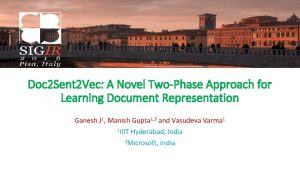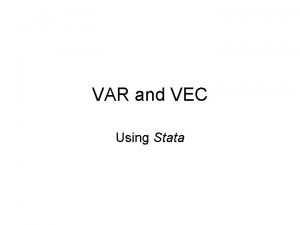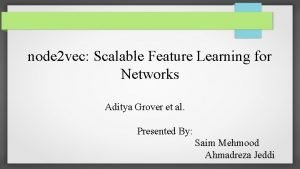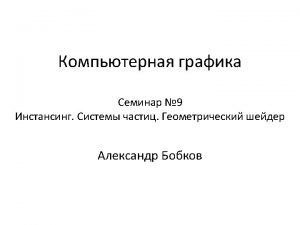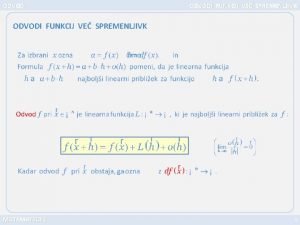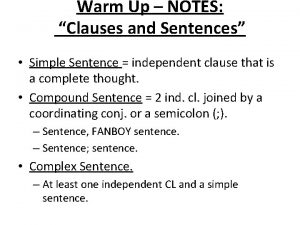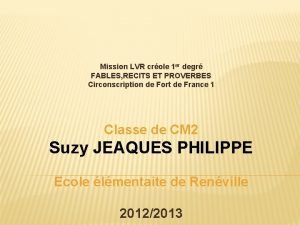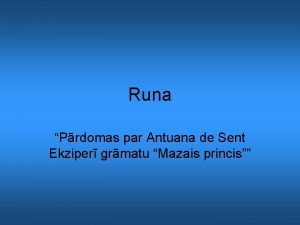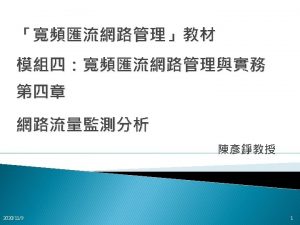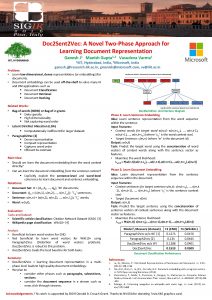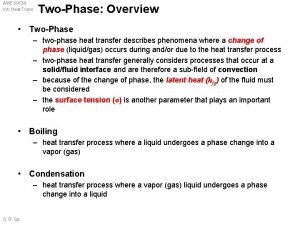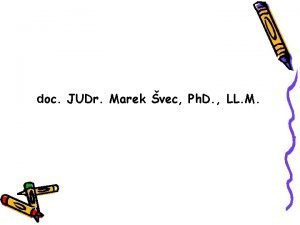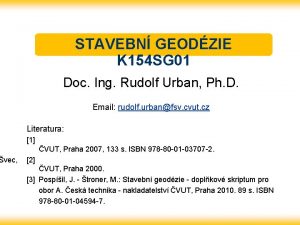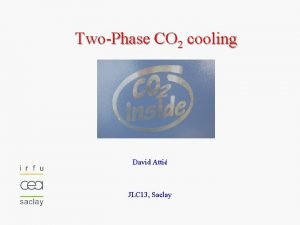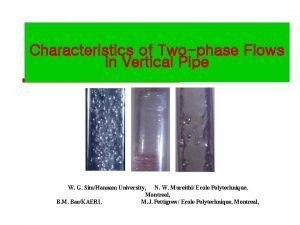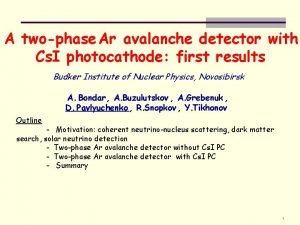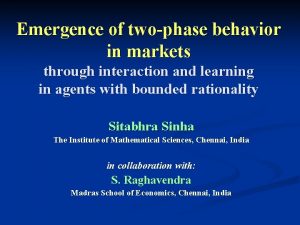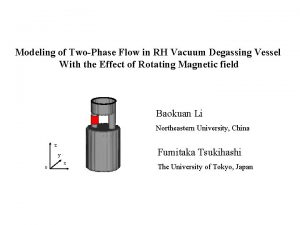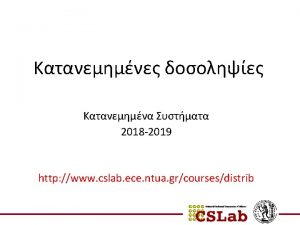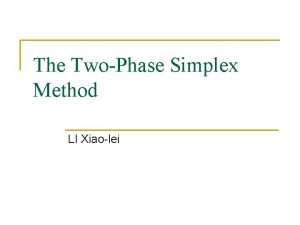Doc 2 Sent 2 Vec A Novel TwoPhase


![Power of Neural Networks • Bag-of-words (BOW) or Bag-of-n-grams [Harris et al. ] § Power of Neural Networks • Bag-of-words (BOW) or Bag-of-n-grams [Harris et al. ] §](https://slidetodoc.com/presentation_image_h2/5e17408b73746e92fe513de7f9a0af65/image-3.jpg)













- Slides: 16

Doc 2 Sent 2 Vec: A Novel Two-Phase Approach for Learning Document Representation Ganesh J 1, Manish Gupta 1, 2 and Vasudeva Varma 1 1 IIIT Hyderabad, India 2 Microsoft, India

Problem • Learn low-dimensional, dense representations (or embeddings) for documents. • Document embeddings can be used off-the-shelf to solve many IR and DM applications such as, § Document Classification § Document Retrieval § Document Ranking
![Power of Neural Networks Bagofwords BOW or Bagofngrams Harris et al Power of Neural Networks • Bag-of-words (BOW) or Bag-of-n-grams [Harris et al. ] §](https://slidetodoc.com/presentation_image_h2/5e17408b73746e92fe513de7f9a0af65/image-3.jpg)
Power of Neural Networks • Bag-of-words (BOW) or Bag-of-n-grams [Harris et al. ] § Data sparsity § High dimensionality § Not capturing word order • Latent Dirichlet Allocation (LDA) [Blei et al. ] § Computationally inefficient for larger dataset. • Paragraph 2 Vec [Le et al. ] § Dense representation § Compact representation § Captures word order § Efficient to estimate

Paragraph 2 Vec • Learn document embedding by predicting the next word in the document using the context of the word and the (‘unknown’) document vector as features. • Resulting vector captures the topic of the document. • Update the document vectors, but not the word vectors [Le et al. ] • Update the document vectors, along with the word vectors [Dai et al. ] § Improvement in the accuracy for document similarity tasks.

Doc 2 Sent 2 Vec Idea - Being granular helps • Should we learn the document embedding from the word context directly? • Can we learn the document embedding from the sentence context? § Explicitly exploit the sentence-level and word-level coherence to learn document and sentence embedding respectively.

Notations • Document Set: D = {d 1, d 2, …, d. M}; ‘M’ documents; • Document: dm = {s(m, 1), s(m, 2), …, s(m, Tm)}; ‘Tm’ sentences; • Sentence: s(m, n) = {w(n, 1), w(n, 2), …, w(n, Tn)}; ‘Tn’ words; • Word: w(n, t); Doc 2 Sent 2 Vec’s goal is to learn low-dimensional representations of words, sentences and documents as a continuous feature vector of dimensionality Dw , Ds and Dd respectively.

Architecture Diagram

Phase 1: Learn Sentence Embedding Idea: Learn sentence representation from the word sequence within the sentence. Input Features: § Context words for target word w(n, t): w(n, t-cw), …, w(n, t-1), w(n, t+1), …, w(n, t+cw) (where ‘cw’ is the word context size) § Target Sentence: s(m, n) (where ‘m’ is the document id) Output: w(n, t) Task: Predict the target word using the concatenation of word vectors of context words along with the sentence vector as features. § Maximize the word likelihood: Lword = P(w(n, t)| w(n, t-cw), …, w(n, t-1), w(n, t+1), …, w(n, t+cw), s(m, n))

Phase 2: Learn Document Embedding Idea: Learn document representation from the sentence sequence within the document. Input Features: § Context sentences for target sentence s(m, t): s(m, t-cs), …, s(m, t-1), s(m, t+1), …, s(m, t+c. S) (where ‘c. S’ is the sentence context size) § Target Document: d(m) Output: s(m, t) Novel Task: Predict the target sentence using the concatenation of sentence vectors of context sentences along with the document vector as features. § Maximize the sentence likelihood: Lsent = P(s(m, t)| s(m, t-cs), …, s(m, t-1), s(m, t+1), …, s(m, t+c. S), d(m))

Training • Overall objective function: L = Lword + Lsent • Use Stochastic Gradient Descent (SGD) to learn parameters. • Use Hierarchical Softmax (Mikolov et al. ) to facilitate faster training.

Evaluation • Dataset § Citation Network Dataset (CND): Sampled 8000 research papers belonging to one of the 8 different computer science fields. [Chakraborty et al. ] § Wiki 10+ Dataset: 19, 740 Wikipedia pages belonging to one or more of the 25 different social tags. [Zubiaga et al. ] • Models (Including baselines) § Paragraph 2 Vec w/o WT [Le et al. ]: Paragraph 2 Vec algorithm without Word Training. § Paragraph 2 Vec [Dai et al. ] § Doc 2 Sent 2 Vec w/o WT: Our approach without Word Training. § Doc 2 Sent 2 Vec

Scientific Article Classification Model F 1 Paragraph 2 Vec w/o WT 0. 1275 Paragraph 2 Vec 0. 135 Doc 2 Sent 2 Vec w/o WT 0. 1288 Doc 2 Sent 2 Vec 0. 1513 • Beneficial to learn word vectors too. (~6% and ~18% F 1 increase for Paragraph 2 Vec and Doc 2 Sent 2 Vec) • Doc 2 Sent 2 Vec beats the best baseline by ~12%.

Wikipedia Page Classification • Not beneficial to learn word vectors too for Paragraph 2 Vec shown by ~7% decline in F 1 score. (Problem: Semantically accurate word vectors gets distorted during training) • Doc 2 Sent 2 Vec robust to the above problem shown by ~27% increase in F 1 score. • Doc 2 Sent 2 Vec beats the best baseline by ~7%. Model F 1 Paragraph 2 Vec w/o WT 0. 0476 Paragraph 2 Vec 0. 0445 Doc 2 Sent 2 Vec w/o WT 0. 0401 Doc 2 Sent 2 Vec 0. 0509

Conclusion and Future Works • Proposed Doc 2 Sent 2 Vec – a novel approach to learn document embedding in an unsupervised fashion. • Beats the best baseline in two classification tasks. Future Work: • Extend to a general multi-phase approach where every phase corresponds to a logical sub-division of a document like words, sentences, paragraphs, subsections, sections and documents. • Consider the document sequence in a stream such as news clickthrough streams [Djuric et al. ].

References 1. Harris, Z. : Distributional structure. Word, 10(23). (1954) 146 – 162 2. Blei, D. , Ng, A. Y. , Jordan, M. I. : Latent Dirichlet Allocation. In: JMLR. (2013) 3. Le, Q. , Mikolov, T. : Distributed Representations of Sentences and Documents. In: ICML. (2014) 1188 -1196 4. Dai, A. M. , Olah, C. , Le, Q. V. , Corrado, G. S. : Document embedding with paragraph vectors. In: NIPS Deep Learning Workshop. (2014) 5. Chakraborty, T. , Sikdar, S. , Tammana, V. , Ganguly, N. , Mukherjee, A. : Computer Science Fields as Groundtruth Communities: Their Impact, Rise and Fall. In: ASONAM. (2013) 426 -433 6. Mikolov, T. , Chen, K. , Corrado, G. , Dean, J. : Efficient Estimation of Word Representations in Vector Space. In: ICLR Workshop. (2013) vol. abs/1301. 3781 7. Djuric, N. , Wu, H. , Radosavljevic, V. , Grbovic, M. , Bhamidipati, N. : Hierarchical Neural Language Models for Joint Representation of Streaming Documents and their Content. In: WWW. (2015) 248 -255

References 8. Bengio, Y. , Ducharme, R. , Vincent, P. , Jauvin, C. : A Neural Probabilistic Language Model. In: JMLR. (2003) 1137 -1155 9. Collobert, R. , Weston, J. , Bottou, L. , Karlen, M. , Kavukcuoglu, K. , Kuksa, P. : Natural Language Processing (Almost) from Scratch. In: JMLR. (2011) 2493 -2537 10. Morin, F. , Bengio, Y. : Hierarchical Probabilistic Neural Network Language Model. In: AISTATS. (2005) 246252 11. Pennington, J. , Socher, R. , Manning, C. D. : Glo. Ve: Global Vectors for Word Representation. In: EMNLP. (2014) 1532 -1543 12. Rumelhart, D. , Hinton, G. , Williams, R. : Learning Representations by Back-propagating Errors. In: Nature. (1986) 533 -536 13. Dos Santos, C. N. , Gatti, M. : Deep convolutional neural networks for sentiment analysis of short texts. In: COLING. (2014) 69 -78 14. Zubiaga, A. : Enhancing navigation on wikipedia with social tags. In: arxiv. (2012) vol. abs/1202. 5469
 Doc to vec
Doc to vec Stata vec
Stata vec Vec workforce connection
Vec workforce connection Ivila
Ivila Node2vec: scalable feature learning for networks.
Node2vec: scalable feature learning for networks. Std::uniform
Std::uniform Vec grundy va
Vec grundy va Vector technologies
Vector technologies Funkcije več spremenljivk
Funkcije več spremenljivk Sentences from before
Sentences from before Rara simenn sent
Rara simenn sent To celia
To celia God sent his son they called him jesus
God sent his son they called him jesus Shipping advise
Shipping advise Chapter 16 hunger games
Chapter 16 hunger games Antuāns de sent-ekziperī mazais princis
Antuāns de sent-ekziperī mazais princis Bits sent
Bits sent
